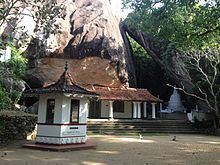Architectural style Cave temple Architectural type Buddhist temple | ||
 | ||
Heritage designation Archaeological protected monument (22 November 2002) Similar Warana Raja Maha Vihara, Maligatenna Raja Maha Vihara, Velgam Vehera, Buddhist temple, Horagolla National Park | ||
Pilikuththuwa Raja Maha Vihara (Sinhalaː පිළිකුත්තුව රජ මහා විහාරය ) is an ancient Cave temple situated in Mahara of Gampaha, Sri Lanka. It is located on Gampaha - Wathurugama road approximately 3.8 km (2.4 mi) away from Miriswatta junction and 1.6 km (0.99 mi) from the ancient Buddhist temple, Maligatenna Raja Maha Vihara. Currently this temple has been declared as one of archaeological site in Sri Lanka.
Pilikuththuwa Raja Maha Vihara is considered as one of the Buddhist temple with highest number of drip ledged rock caves in Sri Lanka. It is said that this temple has 99 rock caves with drip ledges, spread about 200 acres of total area. As today 77 of caves have been identified and their numbers are marked on each cave.
Beside the rock caves, numbers of water tanks with underground water channels, large number of Ola leaf manuscripts, paintings of Kandyan era and old wooden bridge with Dutch architectural features can be found in the vihara premises.
History
As the archaeological evidences, it is believed that this area was inhabited since pre historic time periods. Also three rock inscriptions with Brahmi characters, found in the caves in vihara premises prove that Pilikuththuwa temple is existed as a religious place since pre-Christian era. According to the legends connected with this temple describe King Valagamba (89-77 BC) used to stay in this historical place from time to time during the invasion from South India.
Uruwala, Maligatenna, Warana, Miriswatta and Koskandawala cave temples, situated in the vicinity of the Pilikuththuwa cave complex are also said to be from one major cave site in the early Anuradhapura period.
